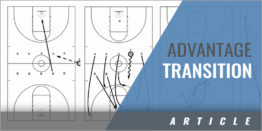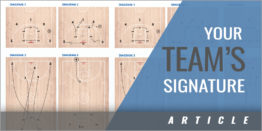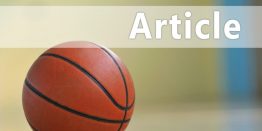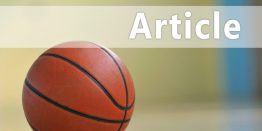|
By: Tony Bennett - University of Virginia Originally Published in: Time Out Magazine Provided by: National Association of Basketball Coaches
SHOT BUILDER: Objective: To have players "systematically" master shot mechanics. Particular emphasis is placed on straight shot-line delivery, strong legs, consistent hand placement/follow-through and shooting rhythm. (Each shooting segment typically lasts 30-45 seconds) Description: (1) "Shot-Line Drill": Player shoots the ball off the side of the backboard beginning at 10-12 feet and working out to the limit of his range. An "on-line" shot will return directly to the shooter. (2) "Feet Set Drill": Players shoot from the limit of their range. Drill begins with shooters' feet set (no stepping into the shot) with right foot slightly ahead of left foot (for right-handed shooter) and knees bent (don't wait to bend knees until after the ball is caught). The player catches and shoots without dipping the ball. (3) "Step and Shoot Drill": This drill is very similar to the "Feet Set Drill" except the shooter starts with his shooting foot back and moves it into shooting position 2 ON 1 FINISHING: Objective: To help players develop dexterity and decision-making skills around the rim versus live defense. Description: The team is divided into two lines. The first two in each line begin at the three-point line, lane line extended, one of the two has a ball. One defender positions himself just above the charge circle. The goal is to make 10 consecutive shots without turnovers or deflections. Each player is limited to two dribbles and each pair is limited to two passes (one or zero is preferred). The offensive players are not allowed to pump-fake the defender. TEACHING POINT: It is imperative that the ball handler attack the basket before making a decision. Force the defender to commit. 3 ON 3 CLOSEOUT: Objective: To develop an understanding of basic "Pack" principles and to provide maximum repetitions of basic "Pack" techniques (close-outs, vision, stance, on-ball discipline and talk). Description: This drill is 3 on 3 live! Coach starts with a ball underneath the rim. Three offensive players are positioned outside the three-point line; one at each wing and one at the top of the key. Each of three defenders begin with one foot in the charge circle. The drill begins with the coach throwing the ball to any of the offensive players. "Stationary Offense": Offensive players are immediately trying to score HOWEVER each must stay within their third of the court (no cuts to another third nor screening for each other) and are limited to 2 dribbles each time they touch it. The drill ends when the offense scores or the defense gets a stop (defensive rebound or turnover). "Moving Offense": Same offensive rules as above but offense is allowed to move anywhere on the court after making a pass. TRANSITION DEFENSE: Objective: To train our players to convert from offense to defense. As we deliver a shot we immediately expect our Description: Before the drill begins we position the "offensive transition team" in the following positions: two guys on each sideline (FT line extended) and the post player out-of-bounds under the basket. A coach has a ball and positions himself on the baseline. The drill begins with 5 guys executing their % court offense (5 vs 0). As soon as a shot is taken the players convert to defense as described above (1 and 2 man back on the shot, etc). As soon as the ball hits the rim the coach with the ball throws it to the PG on the 2nd team. The 2nd team pushes the ball in transition while trying to get the best quick shot possible. The defensive transition team is working to get the ball stopped as quickly as possible, establish match-ups and settle into their half-court defense. The drill ends when the 2nd team scores or when the first team gets a stop (forced turnover or defensive rebound).
|
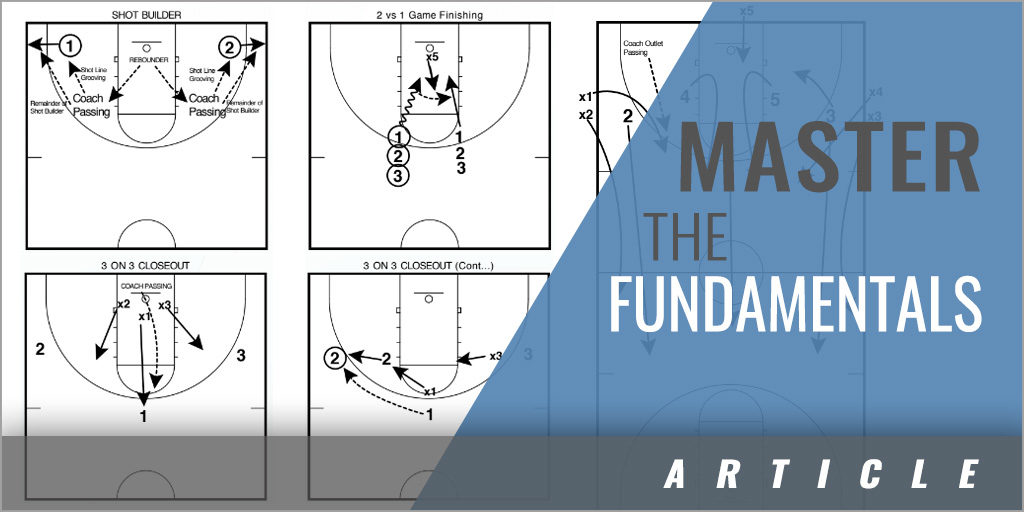


 At the University of Virginia we are committed to mastering the fundamentals of the game. Developing each player's skill level is one of our program's highest priorities. We intentionally focus on the details of shooting, finishing and both half-court and transition defense on a daily basis. We believe our consistent, systematic, basic attention to these building blocks produces habits that stand up in the most pressure packed situations. Below are four examples of drills we use to perfect our players' skills in the areas listed above. Please keep in mind that we expect every pass, cut, dribble, shot, closeout, slide and repetition to be executed at game speed.
At the University of Virginia we are committed to mastering the fundamentals of the game. Developing each player's skill level is one of our program's highest priorities. We intentionally focus on the details of shooting, finishing and both half-court and transition defense on a daily basis. We believe our consistent, systematic, basic attention to these building blocks produces habits that stand up in the most pressure packed situations. Below are four examples of drills we use to perfect our players' skills in the areas listed above. Please keep in mind that we expect every pass, cut, dribble, shot, closeout, slide and repetition to be executed at game speed.

